Small corners for the kitchen: varieties of models and features of choice

When choosing furniture for kitchen arrangement, a considerable part of buyers pay attention to small kitchen corners. With their compact size, they are sometimes able to comfortably accommodate not only the owners of the house, but also their guests. The material of this article will tell you about what these sets of furniture are, what their advantages and disadvantages, and also what are the nuances of their choice.

Advantages and disadvantages
A kitchen corner means a set of furniture for the kitchen, providing for the presence of a dining group. The main element of such a set is a dining table, the secondary components may be different. Small kitchen corners have many advantages:
- their purchase is often more profitable in comparison with the purchase of each piece of furniture separately;
- such products are designed with an emphasis on saving space and using it as efficiently as possible;
- this furniture is a fully equipped island for a specific purpose, which can be used when zoning space;
- in the interior, kitchen corners often look better than separately purchased furniture;
- these products are designed in the same style, size, texture, which is often not available for separately purchased furniture;
- often this furniture is designed with an emphasis on functionality, and therefore it can be used for different needs;
- in comparison with the usual set, the corners are more convenient and comfortable for users;
- products are made from high-quality raw materials with high performance characteristics;
- models are distinguished by the widest range of configurations, which allows you to choose your option, taking into account the budget and taste preferences;
- the color solutions of the sets are varied, which makes it easy to match them to a specific background design of the interior;
- small corners for the kitchen, along with their functionality, set the desired status for the interior of a particular kitchen;
- in the lines of different manufacturers, you can find mini-sets that fit perfectly into small-sized kitchens.






With a number of positive characteristics, this furniture has several disadvantages:
- in small towns it is difficult to choose these sets according to the style of the existing kitchen set;
- not all dining groups are suitable for non-standard kitchen layouts in apartment buildings in our country;
- with an increase in the elements of the set, the area required for the placement of the corners increases;
- not always compact sets offered for sale are versatile - for some you have to separately buy chairs or stools;
- if stores buy them for assembly on a cheap basis, the details of the set may differ in different shades or type of texture;
- most models of compact corners are designed for no more than 5-6 users.




Views
Kitchen corner manufacturers today are able to surprise customers with various configurations of models. Wherein all products by design features and filling can be conditionally divided into several groups... Some of them do not have a table, which allows you to buy it separately. Others are notable in that they provide for the assembly of the corner in both the left-hand and right-hand versions. For mini options, the table model can be transformable: the table can be roll-out or sliding.


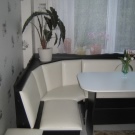



Traditional
These furniture sets consist of a dining table and a kitchen bench. Its configuration can be very diverse. For example, it can be a model with the shape of a regular bench, an option with a back. In this case, the models of the corners can be both classic straight (linear) and angular. Often, a bench with a table is complemented by compact stools, sometimes its shape is more like a compact and narrow sofa, the model of which can be both straight and angular.

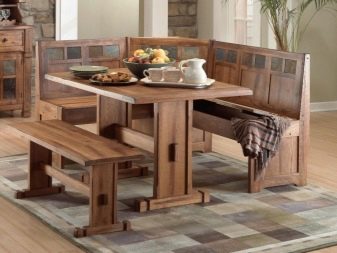
With shelves
This group includes models supplemented with shelves for storing necessary things. Models of this group are not as popular today as other analogs. However, with a shortage of space, the shelves located on the sides or in front of the kitchen benches will significantly expand the functionality of the furniture ensemble and increase the degree of comfort for household members in the kitchen. In addition, the kits can also include hanging shelves, which is good for kitchens where there is no place for placing floor boxes.



With drawers
These sets are nothing more than a table, a couple of stools and a kitchen bench, under the seat of which there are 1 or 2 relatively spacious drawers. They are large enough to accommodate utensils that are not often used. In addition, housewives often use these boxes for storing other things in order to visually reduce the amount of small things that usually fill a small kitchen. As a rule, in order to gain access to the box, it is enough just to fold the seat back.

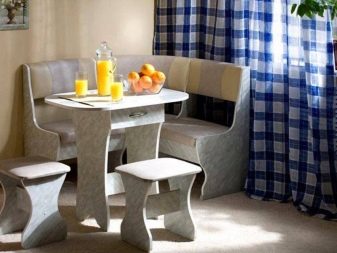

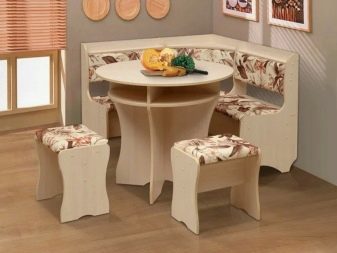
With bar counter
These kits differ from other varieties by the presence of an attachment that acts as a bar. From an aesthetic point of view, these sets look very original. In addition, the bar counter significantly saves space, which is important for kitchens with a minimum of usable space. These models are popular with interior designers, they fit well into the design of kitchens and are effective methods of zoning space.




With built-in berth
Compact corners with a berth differ from other varieties in that they provide for a transformation system that allows you to turn a kitchen bench, similar to a sofa, into a narrow bed. The mechanism for transforming the bench can be different, as well as the type of the benches themselves. These sets are expensive, they look respectable, however, they also take up more space in the kitchen than other analogues. The inconvenience of transformable models is the need to move the table.




Bay windows
For small kitchens with a bay window, brands offer sets that differ from the rest in the form of individual or several corner elements. The main difference between such furniture is that it repeats the shape of the bay window ledge, which is necessary so that it can be placed close to the bay window. If it is a table, then it can be triangular, if it is a kitchen bench, then it can be modular.




Such corners are more expensive than the classic options, they are often made to order according to individual measurements of the existing bay window.
By table type
The table at the small corners differs in shape. In the traditional version, it can be rectangular with sharp or rounded edges. In addition to these models, brands include oval and triangular tables in the sets. In addition, on sale you can find small-sized furniture with a round dining table. The compact is different for different sets, as well as the material of manufacture.

Materials (edit)
In the production of small kitchenettes, different raw materials are used, ranging from wood of the best grades to MDF and even plastic. Wood is considered the best type of raw material - of all analogues, it is the most durable and practical, despite the fact that during long-term operation it is gradually exposed to moisture. However, this material is not only more environmentally friendly - it has high aesthetic characteristics.


Chipboard - a budget option, is a pressed product of wood processing. This material is significantly inferior to her in aesthetics, furniture made of it is designed for only a few years of operation. Depending on the quality of the assembly, the service life can be more than 5 years. However, water and frequent cleaning often lead to peeling of the edge from the side edges of the table.

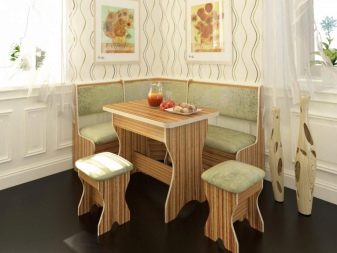
Metal in the corners is used as a frame and supports for a table, stools and chairs. Metal elements in the interior of kitchens look stylish and effective, wood stands out favorably against the background of metal.


Glass in small corners is used to make countertops. Plastic, regardless of its color and density, is considered not the best material. It is fragile and quickly deteriorates even from insignificant mechanical damage.


Design
Kitchen corner design solutions can be very diverse. They can differ in shape, color schemes, upholstery colors and the presence of additional decorative and practical elements. For example, there are models with benches, on which you can lay special mats for more comfort. Someone puts several small pillows under their backs. When buying, you can bet on the color of the upholstery. Sometimes it is she who is able to set the right mood and indicates that the corner belongs to a certain stylistic design solution. Models can have plain upholstery. Often they are made in contrasting solutions, which allows you to choose your version taking into account the color of the headset or wallpaper, apron, print on curtains, a picture or a shade of a flower pot.

The print in the finish of the corners can be located not only on the seat upholstery - there are options on sale in which it is on the backs. In addition, the design of modifications can be expressed in forms: some options give a striving for classics, others strive for ergonomics.Models can be tall and compact, as well as low, complemented by stools that look more like hard poufs.

Belonging to a particular stylistic solution can be expressed in the theme of the drawing, the type of material and upholstery used, the color of the products. The shape, texture, emphasis on the resources of a particular style help the buyer choose the right corner option for his kitchen. The backs of the benches can be straight and arched (arched type). The seats of the chairs can be made in the form of a soft square, a circle and a rounded triangle.

Criterias of choice
The main characteristics, which you should pay attention to when buying are:
- the size of the entire corner (important for rooms with a minimum of usable area);
- corner orientation (not all models can change the corner element from right to left);
- upholstery material for seats or benches (priority is leather or leatherette);
- the material from which the frame is made (the stronger, the longer the operation);
- filler for seat upholstery near stools or benches (in priority polyurethane foam);
- corner color (should be combined with existing furniture);
- design (must correspond to the style of a particular interior).


In addition, you need to pay attention to the type of furniture: the corner can be typical hard and soft. Products with a soft sofa are more comfortable for users. During a visual examination, it is necessary to pay attention to such a moment as the height of the backs. If there is sufficient space, the design of the corner can provide for a structure with a bar to which the hanging cushions are attached.

If in a small kitchen you want to put just a similar version of the corner, it is important to choose a product with small and not too bulky pillows... At the same time, in order to assess the degree of convenience when placing around the corner, it is advisable to carry out a "fitting" before the purchase. It is necessary for the reason that furniture often seems visually comfortable, but during operation it turns out to be extremely inconvenient.

In addition, it is worth taking a closer look at the furniture - perhaps in the future it will be possible to pick up or sew removable covers for it.
Going to the store, the buyer is already calculating what kind of furniture he will take. However, there are times when what is on sale does not correspond to the desire and capabilities. In this case, you can order a specific option, taking into account the previously performed measurements, or build on what is in the store. At the same time, preliminary measurements will allow you to choose a corner in order to leave the required distance (60-70 cm or 90 cm) for passing through the kitchen.


If there is very little space in the kitchen, you should refuse a set with a sofa, replacing it with a set with a kitchen bench. Chairs here will also take up too much space, and therefore a bench with a table will be enough to accommodate and save space. As a last resort, the set can include a pair of upholstered stools.

When buying, pay attention to the practicality of the upholstery. Ideally, it should be a material that does not allow moisture to pass through, does not absorb foreign odors, and is easy to clean. The type of filler also matters: foam rubber, which is used in cheap corners, deteriorates very quickly, polyurethane foam holds its shape better and is environmentally friendly. As for the material of manufacture, wood processing products often contain a high concentration of formaldehyde. As a last resort, you should choose E1 class DPS.

If the buyer's budget is not limited, it is worth purchasing a corner with a frame made of wood (for example, birch or pine). When buying a folding type corner, you need to pay attention to the fact that the transformation needs additional space. Therefore, the table and stools must be relatively mobile. In addition, these kitchens do not require models with armrests and cushions.

Inspecting the corner, it is necessary to check the quality of the fittings and the reliability of the fasteners. Nothing should hang anywhere, and if this is noted, but the seller assures that the furniture is simply not reinforced, you should not completely trust it. Often, the material from which the corner is made is not of the best quality, and therefore, when it is assembled, the screws scroll in some places. You will not be able to tighten these connections, which is why the furniture will hang loose, which is considered a marriage.


You should pay attention to the quality of the seams of the upholstery. There is no overlap or needle marks on good furniture. You also need to take a closer look at the thread: reputable brands perform seams using strong and thick threads to prevent mechanical damage and accidental ripping.
Accommodation options
The placement of the kitchenette depends on the size of the particular kitchen and the complexity of its layout. If it has partitions, you can use them, thereby using the space zoning technique. In narrow rooms, the layout should be linear, which is why it is undesirable to put a corner opposite the working area. However, at the same time, it is possible to place it against the wall opposite the front door if there is no window in this place or the bench does not reach it.
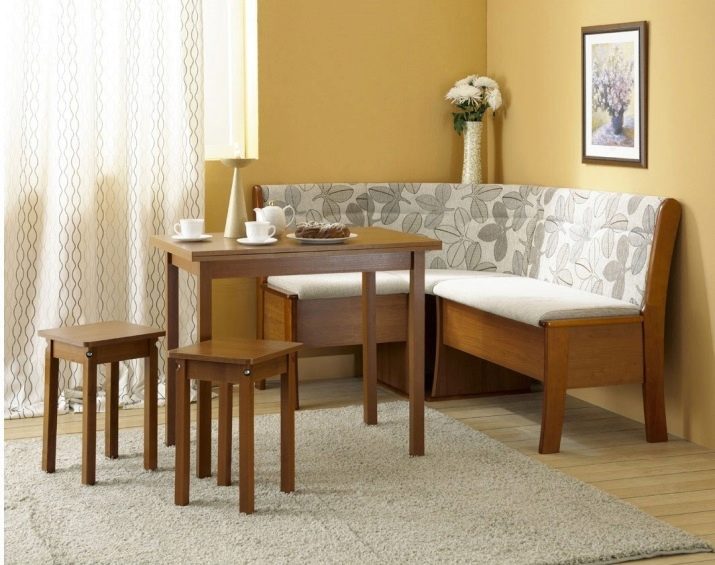
Narrow rooms should not be visually stretched even further. Therefore, you need to install furniture with a long part to a short wall. As for the place, it is undesirable to put the dining group in close proximity to the stove or work table, which is used for cooking. This is impractical and will result in more frequent cleaning of the table and seats.

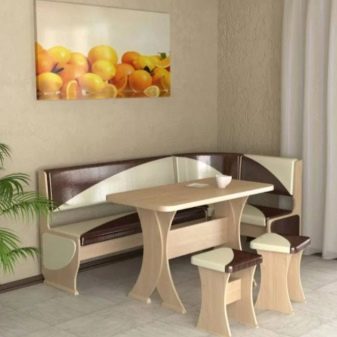
The corner can be located near the balcony door, but in such a way that when it is opened and closed, nothing interferes with access to the furniture. In such cases, the set usually does not have chairs or stools, it is limited to a kitchen bench and a laconic table with rounded edges. If the room has niches, and the layout can be angular and U-shaped, the corner can be placed in it. When the room is wide, and the wall with the entrance door is long, a compact corner for two persons can be placed on the side of the door by moving the bench or modular bench close to the wall.

When choosing a place for the location of the kitchen corner, you must consider: furniture should not violate the working triangle rule. Equal distances must be maintained between the refrigerator, stove and sink. In this case, the corner should not stand between them, as well as shorten the gaps for moving around the kitchen.

In other words, the place for the corner should not fit into the territory of the working triangle.
If there is space between the headset and the wall with a window, it is this part of the room that can be taken under a corner. In this place, it is worth placing a set of furniture with a laconic L- or U-shaped bench, equipped with internal drawers. It is better that her table has one reliable and stable support than 4 legs. In this case, one side of the table can be beveled, which is good in order to avoid injury when moving in a small kitchen.

For information on how to choose a small corner for the kitchen, see the next video.








